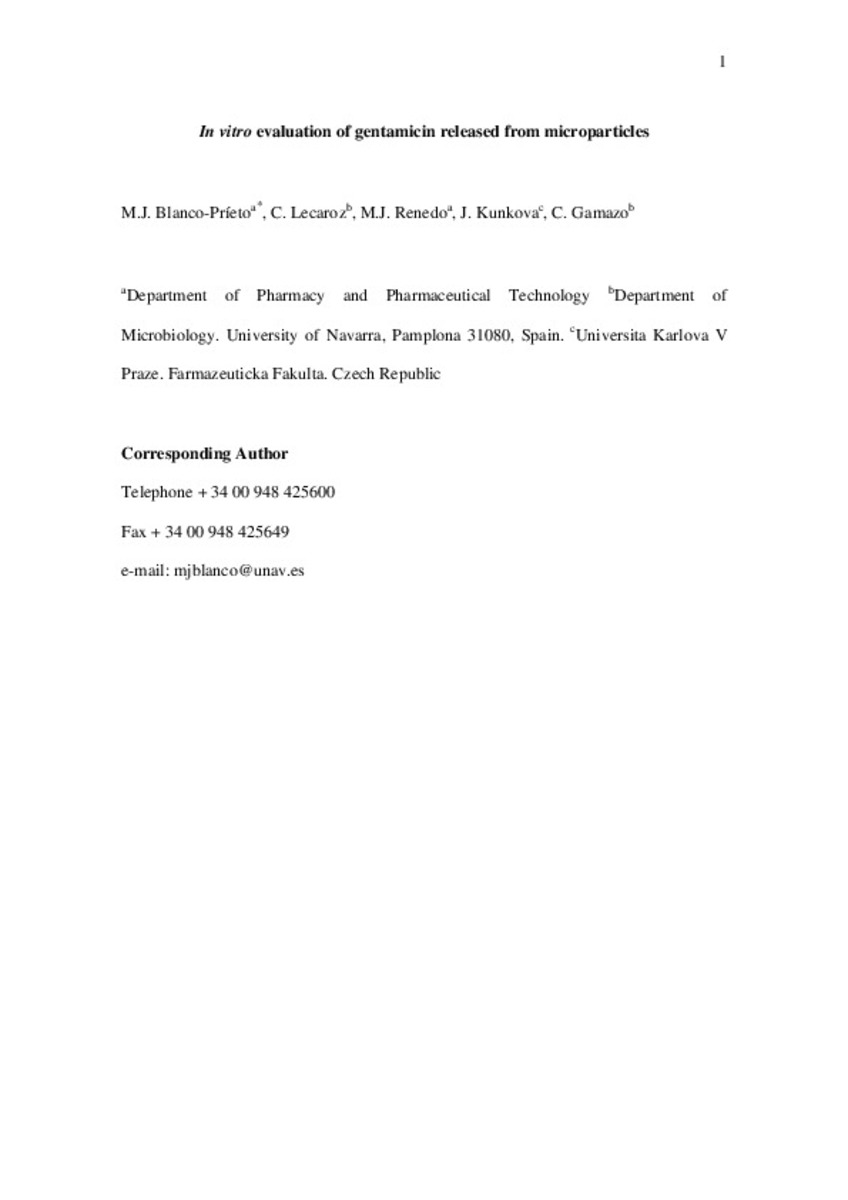Full metadata record
| DC Field | Value | Language |
|---|---|---|
| dc.creator | Blanco-Prieto, M.J. (María José) | - |
| dc.creator | Lecaroz, M.C. (María Concepción) | - |
| dc.creator | Renedo, M.J. (María Jesús) | - |
| dc.creator | Kunkova, J. (J.) | - |
| dc.creator | Gamazo, C. (Carlos) | - |
| dc.date.accessioned | 2012-05-31T11:46:11Z | - |
| dc.date.available | 2012-05-31T11:46:11Z | - |
| dc.date.issued | 2002-08 | - |
| dc.identifier.citation | Blanco-Prieto M, Lecároz C, Renedo M, Kunkova J, Gamazo C. In vitro evaluation of gentamicin released from microparticles. Int J Pharm 2002 Aug 21;242(1-2):203-206. | es_ES |
| dc.identifier.issn | 0378-5173 | - |
| dc.identifier.uri | https://hdl.handle.net/10171/22383 | - |
| dc.description.abstract | Gentamicin (GEN) is an aminoglycoside antibiotic with a potent antibacterial activity against a wide variety of bacteria. However, its poor cellular penetration limits its use in the treatment of infections caused by intracellular pathogens. One potential strategy to overcome this problem is the use of particulate carriers that can target the intracellular sites of infection. In this study GEN was ion-paired with the anionic AOT surfactant to obtain a hydrophobic complex (GEN–AOT) that was formulated as a particulated material either by the precipitation with a compressed antisolvent (PCA) method or by encapsulation into poly(d,l-lactide-co-glycolide) (PLGA) nanoparticles (NPs). The micronization of GEN–AOT by PCA yielded a particulated material with a higher surface area than the non-precipitated complex, while PLGA NPs within a size range of 250–330 nm and a sustained release of the drug over 70 days were obtained by preparing the NPs using the emulsion solvent evaporation method. For the first time, GEN encapsulation efficiency values of ∼100% were achieved for the different NP formulations with no signs of interaction between the drug and the polymer. Finally, in vitro studies against the intracellular bacteria Brucella melitensis, used as a model of intracellular pathogen, demonstrated that the bactericidal activity of GEN was unmodified after ion-pairing, precipitation or encapsulation into NPs. These results encourage their use for treatment for infections caused by GEN-sensitive intracellular bacteria. | es_ES |
| dc.language.iso | eng | es_ES |
| dc.publisher | Elsevier | es_ES |
| dc.rights | info:eu-repo/semantics/openAccess | es_ES |
| dc.subject | Gentamicin | es_ES |
| dc.subject | Hydrophobic ion pairing | es_ES |
| dc.subject | Supercritical fluids | es_ES |
| dc.subject | Drug delivery systems | es_ES |
| dc.subject | Intracellular pathogens | es_ES |
| dc.title | In vitro evaluation of gentamicin released from microparticles | es_ES |
| dc.type | info:eu-repo/semantics/article | es_ES |
| dc.type.driver | info:eu-repo/semantics/article | es_ES |
| dc.identifier.doi | http://dx.doi.org/10.1016/S0378-5173(02)00158-8 | es_ES |
Files in This Item:
Statistics and impact
Items in Dadun are protected by copyright, with all rights reserved, unless otherwise indicated.






